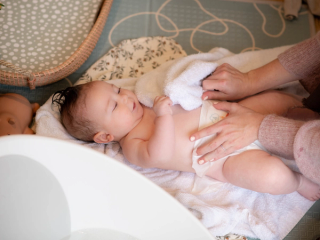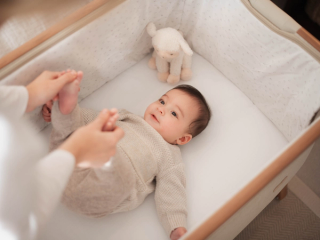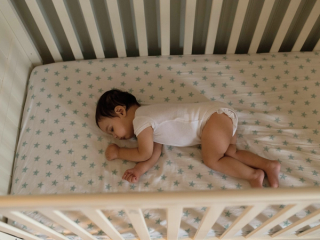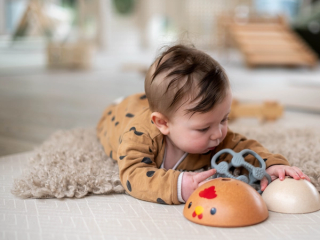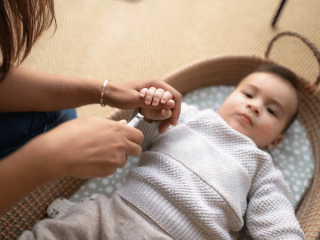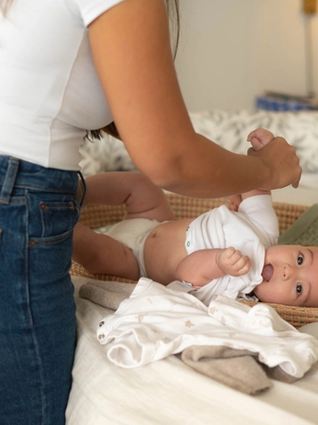
- Home
- Advice Hub
- Newborn
- Essential Newborn Care
- The Many Colours Of Baby Poo!
The many colours of baby poo!
Who knew that your baby’s business could change so rapidly and leave you feeling clueless as to what is right or wrong? Baby poo can come in a whole host of textures and colours and the vast majority are perfectly normal. Here is a little guide.
Prior to embarking on your parenting journey, you may have found yourself slightly baffled when new parents shared their apparent obsession with the colour of their baby’s poo. Maybe you even made a silent promise to yourself that, when the time comes, the last thing you will do is spend any time talking to near strangers about the content of your baby’s nappy. If this is the case, you can join the queue of thousands, if not millions, of new parents who have made the exact same vow, yet found themselves falling into their own trap the second their little one is born!
Who knew that your baby’s business could change so rapidly and leave you feeling clueless as to what is right or wrong? Baby poo can come in a whole host of textures and colours and the vast majority are perfectly normal. Here is a little guide:
Days 1 -3 - You baby’s first bowel movement will be black and tar like. This is called Meconium and is made up of blood cells, skin cells, baby hairs, and various other waste matter. You should expect this appearance and consistency to last for about 3 days, then you will find nappy contents become a little smellier and much lighter in colour.
Days 4 - 6 - Enter our pesto nappies! Whilst transitioning away from Meconium, your baby will produce dark greenish stools, which will soon change to a mustard-like appearance. Babies who are breastfed are more likely to have slightly runnier nappies, while their formula-fed friends will pass firmer (not solid) poop, which can also be a little smellier.
If you have a baby girl, it is not uncommon to see a little fresh blood in their nappy. Again, this is perfectly normal, as it is Mum’s hormones working their way out of her system, so she is experiencing a tiny period. This will pass after a couple of nappies and is not unusual. However, if you are worried, touch base with your midwife or GP.
What is normal?
Believe it or not, seeing changes in your baby’s nappies can leave you feeling a little anxious as you wonder what prompted the changes. In the vast majority of cases you will find that, just like adults, babies stools do vary from day to day and what is normal for one baby may not be the same for another.
There are generally differences in stool consistency and colour depending on whether you are feeding your baby breastmilk or formula, but there are no strict rules on what is ‘normal’ - what is important to understand is what is normal for your baby and not to spend your time worrying and comparing with others.
How ‘regular’ should my baby be?
From around 4 weeks of age, babies pass stools on average 3 times a day, but this can range from once every 2-3 days to 6 times a day. When you start introducing some ‘solid’ meals, usually at around 6 months of age, the digestive system adapts and your baby is likely to poo less frequently and the consistency will become thicker and usually darker and smellier too.
At the age of 1 year, the average is 2 poos per day. It is worth remembering that stool size, colour, texture and frequency reflects what has recently been consumed, so the colour of your baby’s stools will vary depending on what food you are feeding them. If you notice a definite change, such as poos becoming very smelly, very watery or harder (particularly if there’s blood in them), you should talk to your doctor or health visitor.
Constipation
Constipation is very common when you start weaning and affects up to 30% of ALL children under the age of 5. If a parent comes to me saying that their baby is not passing frequent stools (less than 3-4 times a week) and the stools are hard, often pellet-like, while baby appears to be in some pain, it’s likely they are constipated.
I usually advise parents to offer sips of water with meals and to try including some fruits such as stewed apples, pears or other soft fruits with their meals to help rehydrate and relieve constipation. Another question I’m often asked is if babies can have wholewheat pasta or breakfast cereals, porridge or wholemeal bread to increase the amount of fibre in their diet and to help with constipation, but the amounts of these should be kept fairly small and not given every day as they can be a bit bulky for babies.
Other things you can try are a warm bath which can sometimes help relax babies and relieve constipation, as can baby massage. I often suggest that parents try lying their baby on his/her back and moving their legs in a bicycling motion – this can often help get things moving!
If these home treatments have not worked, or if your baby appears to be in a lot of pain or discomfort, I would recommend a visit to your GP. They may suggest a laxative, probably lactulose, or other medications, but only try this with their guidance.
Advice & tips

Want to read more? Join the HiPP BabyClub for full access to this article.
As a BabyClub member, you'll get access to a range of exclusive benefits, including:
Monthly competitions
Discounts from our Partners
Expert advice tailored to your little one's age
Weaning recipes
HiPP shop discounts*
*10% off HiPP's online shop does not apply to our First Infant, Anti-Reflux or Comfort Formula Milk.
Important notice: Breastfeeding is best. Follow on milk should only be used as part of a mixed diet from 6 months. Talk to a healthcare professional.





